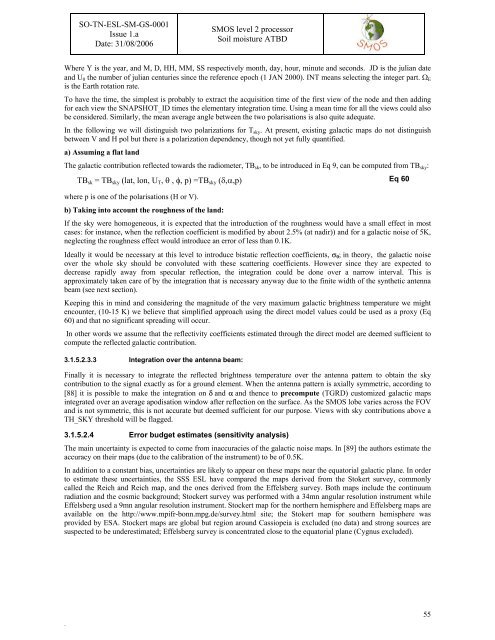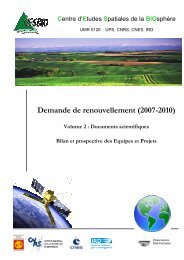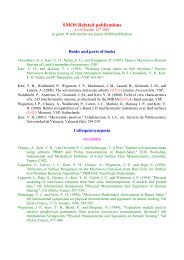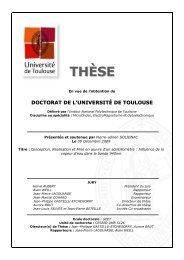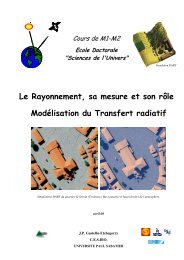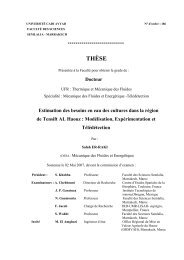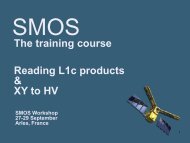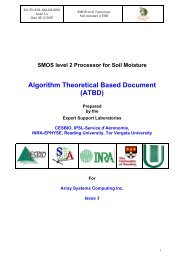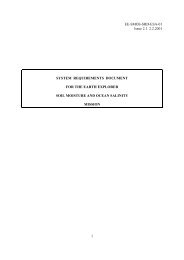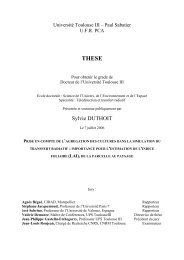Algorithm Theoretical Based Document (ATBD) - CESBIO
Algorithm Theoretical Based Document (ATBD) - CESBIO
Algorithm Theoretical Based Document (ATBD) - CESBIO
You also want an ePaper? Increase the reach of your titles
YUMPU automatically turns print PDFs into web optimized ePapers that Google loves.
SO-TN-ESL-SM-GS-0001<br />
Issue 1.a<br />
Date: 31/08/2006<br />
SMOS level 2 processor<br />
Soil moisture <strong>ATBD</strong><br />
Where Y is the year, and M, D, HH, MM, SS respectively month, day, hour, minute and seconds. JD is the julian date<br />
and U 0 the number of julian centuries since the reference epoch (1 JAN 2000). INT means selecting the integer part. Ω E<br />
is the Earth rotation rate.<br />
To have the time, the simplest is probably to extract the acquisition time of the first view of the node and then adding<br />
for each view the SNAPSHOT_ID times the elementary integration time. Using a mean time for all the views could also<br />
be considered. Similarly, the mean average angle between the two polarisations is also quite adequate.<br />
In the following we will distinguish two polarizations for T sky . At present, existing galactic maps do not distinguish<br />
between V and H pol but there is a polarization dependency, though not yet fully quantified.<br />
a) Assuming a flat land<br />
The galactic contribution reflected towards the radiometer, TB sk , to be introduced in Eq 9, can be computed from TB sky :<br />
TB sk = TB sky (lat, lon, U T , θ , φ, p) =TB sky (δ,α,p) Eq 60<br />
where p is one of the polarisations (H or V).<br />
b) Taking into account the roughness of the land:<br />
If the sky were homogeneous, it is expected that the introduction of the roughness would have a small effect in most<br />
cases: for instance, when the reflection coefficient is modified by about 2.5% (at nadir)) and for a galactic noise of 5K,<br />
neglecting the roughness effect would introduce an error of less than 0.1K.<br />
Ideally it would be necessary at this level to introduce bistatic reflection coefficients, σ 0 ; in theory, the galactic noise<br />
over the whole sky should be convoluted with these scattering coefficients. However since they are expected to<br />
decrease rapidly away from specular reflection, the integration could be done over a narrow interval. This is<br />
approximately taken care of by the integration that is necessary anyway due to the finite width of the synthetic antenna<br />
beam (see next section).<br />
Keeping this in mind and considering the magnitude of the very maximum galactic brightness temperature we might<br />
encounter, (10-15 K) we believe that simplified approach using the direct model values could be used as a proxy (Eq<br />
60) and that no significant spreading will occur.<br />
In other words we assume that the reflectivity coefficients estimated through the direct model are deemed sufficient to<br />
compute the reflected galactic contribution.<br />
3.1.5.2.3.3 Integration over the antenna beam:<br />
Finally it is necessary to integrate the reflected brightness temperature over the antenna pattern to obtain the sky<br />
contribution to the signal exactly as for a ground element. When the antenna pattern is axially symmetric, according to<br />
[88] it is possible to make the integration on δ and α and thence to precompute (TGRD) customized galactic maps<br />
integrated over an average apodisation window after reflection on the surface. As the SMOS lobe varies across the FOV<br />
and is not symmetric, this is not accurate but deemed sufficient for our purpose. Views with sky contributions above a<br />
TH_SKY threshold will be flagged.<br />
3.1.5.2.4 Error budget estimates (sensitivity analysis)<br />
The main uncertainty is expected to come from inaccuracies of the galactic noise maps. In [89] the authors estimate the<br />
accuracy on their maps (due to the calibration of the instrument) to be of 0.5K.<br />
In addition to a constant bias, uncertainties are likely to appear on these maps near the equatorial galactic plane. In order<br />
to estimate these uncertainties, the SSS ESL have compared the maps derived from the Stokert survey, commonly<br />
called the Reich and Reich map, and the ones derived from the Effelsberg survey. Both maps include the continuum<br />
radiation and the cosmic background; Stockert survey was performed with a 34mn angular resolution instrument while<br />
Effelsberg used a 9mn angular resolution instrument. Stockert map for the northern hemisphere and Effelsberg maps are<br />
available on the http://www.mpifr-bonn.mpg.de/survey.html site; the Stokert map for southern hemisphere was<br />
provided by ESA. Stockert maps are global but region around Cassiopeia is excluded (no data) and strong sources are<br />
suspected to be underestimated; Effelsberg survey is concentrated close to the equatorial plane (Cygnus excluded).<br />
.<br />
55


